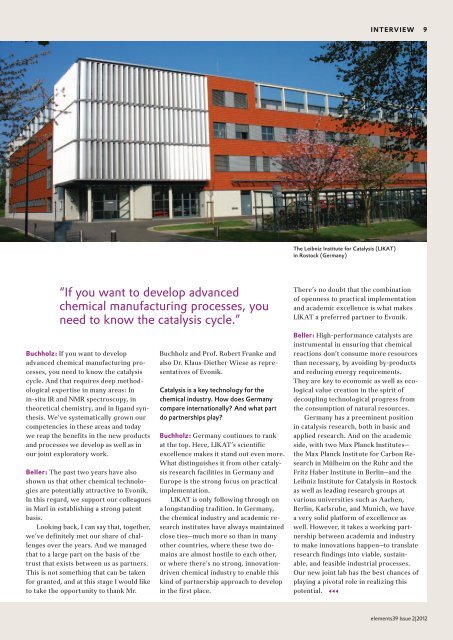Download - Evonik Industries
Download - Evonik Industries
Download - Evonik Industries
Create successful ePaper yourself
Turn your PDF publications into a flip-book with our unique Google optimized e-Paper software.
“If you want to develop advanced<br />
chemical manufacturing processes, you<br />
need to know the catalysis cycle.”<br />
Buchholz: If you want to develop<br />
advanced chemical manufacturing processes,<br />
you need to know the catalysis<br />
cycle. And that requires deep methodological<br />
expertise in many areas: In<br />
in-situ IR and NMR spectroscopy, in<br />
theoretical chemistry, and in ligand synthesis.<br />
We’ve systematically grown our<br />
competencies in these areas and today<br />
we reap the ben efits in the new products<br />
and processes we develop as well as in<br />
our joint explor atory work.<br />
Beller: The past two years have also<br />
shown us that other chemical technologies<br />
are potentially attractive to <strong>Evonik</strong>.<br />
In this regard, we support our colleagues<br />
in Marl in establishing a strong patent<br />
basis.<br />
Looking back, I can say that, together,<br />
we’ve definitely met our share of challenges<br />
over the years. And we managed<br />
that to a large part on the basis of the<br />
trust that exists between us as partners.<br />
This is not something that can be taken<br />
for granted, and at this stage I would like<br />
to take the opportunity to thank Mr.<br />
Buchholz and Prof. Robert Franke and<br />
also Dr. Klaus-Diether Wiese as representatives<br />
of <strong>Evonik</strong>.<br />
Catalysis is a key technology for the<br />
chemical industry. How does Germany<br />
compare internationally? And what part<br />
do partnerships play?<br />
Buchholz: Germany continues to rank<br />
at the top. Here, LIKAT’s scientific<br />
excellence makes it stand out even more.<br />
What distinguishes it from other catalysis<br />
research facilities in Germany and<br />
Europe is the strong focus on practical<br />
implementation.<br />
LIKAT is only following through on<br />
a longstanding tradition. In Germany,<br />
the chemical industry and academic research<br />
institutes have always maintained<br />
close ties—much more so than in many<br />
other countries, where these two domains<br />
are almost hostile to each other,<br />
or where there’s no strong, innovationdriven<br />
chemical industry to enable this<br />
kind of partnership approach to develop<br />
in the first place. potential. 777<br />
InteRVIeW<br />
the Leibniz Institute for Catalysis (LIKAt)<br />
in rostock (Germany)<br />
There’s no doubt that the combination<br />
of openness to practical implementation<br />
and academic excellence is what makes<br />
LIKAT a preferred partner to <strong>Evonik</strong>.<br />
Beller: High-performance catalysts are<br />
instrumental in ensuring that chemical<br />
reactions don’t consume more resources<br />
than necessary, by avoiding by-products<br />
and reducing energy requirements.<br />
They are key to economic as well as ecological<br />
value creation in the spirit of<br />
decoupling technological progress from<br />
the consumption of natural resources.<br />
Germany has a preeminent position<br />
in catalysis research, both in basic and<br />
applied research. And on the academic<br />
side, with two Max Planck Institutes—<br />
the Max Planck Institute for Carbon Research<br />
in Mülheim on the Ruhr and the<br />
Fritz Haber Institute in Berlin—and the<br />
Leibniz Institute for Catalysis in Rostock<br />
as well as leading research groups at<br />
various universities such as Aachen,<br />
Berlin, Karlsruhe, and Munich, we have<br />
a very solid platform of excellence as<br />
well. However, it takes a working partnership<br />
between academia and industry<br />
to make innovations happen—to translate<br />
research findings into viable, sustainable,<br />
and feasible industrial processes.<br />
Our new joint lab has the best chances of<br />
playing a pivotal role in realizing this<br />
9<br />
elements39 Issue 2|2012
















